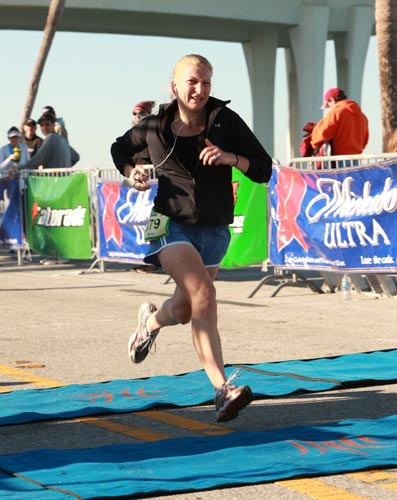Cardio For Sailing
SAILING FIT
By: Meka Taulbee
ACE Certified Personal Trainer
SAILFIT Inc
Cardio for Sailing
Cardio fitness for sailing seems to be a wide open topic and there are so many views and ways to go about it. In this article I present an easy to follow approach to improve your cardiorespiratory fitness for sailing.
There are numerous trainers out there who can tell you to do X, Y and Z and the sad part is that they are telling every client to do the same X, Y and Z no matter what the sport. Even though sailors have long known that sailing is a very athletic sport, it is taking the rest of the training community a while to catch on. The same with any sport you want someone who understands your sport. You wouldn’t want a hockey coach out on the water with you would you? From my experience training sailors, the energy demand to make the boat go at the top speed is higher than most sailors and trainers think it is. Take for example when you are hiking upwind you need to hike full out, keep the bow down, be kinetic and still have the presence of mind to tactically stay in the game. That is a huge load for the body to handle.
First we need to understand really what we are asking the body to do to be able to handle this load. That way we can make sure the exercises we are doing are working with our bodies and working towards our goal. You have no idea how often I see people who feel that they are “working out really hard”, but not seeing results. They are getting results, but just not the ones they were looking for. You and your body have to work together. What you are in essence trying to do is increase your cardiorespiratory endurance level. You goal is to increase the capacity of the lungs to exchange oxygen and carbon dioxide with the blood. This in turn increases the circulatory systems abilities to transport the blood to metabolically active tissues for prolonged periods of time. If done efficiently then you don’t feel any undue fatigue. This last part is extremely important in sailing. Once fatigue sets in it is difficult to hike out completely, keep the bow down and be tactically sharp. Each aspect depends upon the other to function optimally. If you do not feel the fatigue just think how much more easily the other pieces will fall into place.
So where do you begin and how can you increase your cardiorespiratory endurance level? First you should try to establish a solid base of cardio. Depending on your workout style this would be one hour of cardio at a moderate level. You can test by heart rate, the talk test, and just being in tune with your body. Using a heart rate monitor can be a very good way to gage and measure your workouts. If you use a monitor I would suggest shooting for an hour at 60-70% of your max heart rate. If you use the talk test you should be able to complete a sentence, but not carry on a conversation. If you can listen to your body I think it will be the most useful tool to use while you are sailing. If you are 30 minutes into your workout and you feel like you are going to puke you need to slow down. If you haven’t broken a sweat you need to pick up the pace. You’ll start o get a better feel for where your body is at and how much longer you can go before fatigue sets in.
Once you get a solid base level you can start working at increasing that base level. Interval training is a great way to do this especially for sailors. Training in intervals is similar to what your body will experience during any given race. You can do this with any type of cardio you prefer to do. This workout could be considered a staircase workout as well, but I feel these are the types of intervals that would really help in this particular case. If you use a machine like a treadmill, elliptical, spinner or rower you can do intervals in a few different ways. You can start at your base level for 5 minutes and then go up to another level for 3 minutes and then back down to your base for 5. So say your base level is a 7 you would raise it up to an 8 or 8.5 for three minutes and then back down to 7. Another option is to keep raising your level through your workout. If you start at a 7 for five minutes then every two minutes after your first five raise it up a small increment. So here you would be at 7 and after 5 minutes you would raise it up to 7.2, after seven minutes you would raise it up to 7.4, after 9 minutes it would be 7.6. Keep doing this all the way through your workout. When you raise the speed it isn’t by a huge amount and you gradually work into a much faster pace.
If you like to train using a heart rate monitor you can do the same thing. You can also use the heart rate monitor on the machines as well as to go running, biking or swimming. In this case you would start for 5 minutes at 65% of your max heart rate. Then you can go up to 85% for three minutes and then back down to 65%. Again another option is to start at 65% of your max hear rate and then five minutes later go up to 70% for five minutes, then 75% for five minutes, then 80% and all the way up to 95%. If at some point you raise the interval and you really feel winded or sick then go back down to the previous one and just stay there, if that is starting to feel the same way then lower back down another interval. In both of these types of workouts you raise your heart rate and once you reach your desired max your can start to come back down in the same manner until you get back to your base. This is also similar of a pyramid workout, but again I feel it is appropriate for sailing.
Another way to interval train is by using plyometrics. Plyometrics are movements in which a muscle is loaded and then contracted in rapid sequence teaching the muscles to produce maximum force faster. An example exercise would be a tuck jump. Stand with your feet shoulder width apart and jump up as high as you can bringing your knees up to your chest. Try to land softly and immediately repeat. Picture yourself on a trampoline and you are springing back up into the air. Do as many as you can in a row. These explosive movements get your heart rate up and can be extremely effective. You can incorporate these into any part of your workout by either doing a few different sets of plyometric exercises or adding them into your workout intermittently. You could be strength training and stop and do a set of a plyometric exercise then go back to your sets and reps in your strength program. You can do your cardio at your base level and then stop and do a set of these exercises then resume your cardio workout. When I say stop I don’t mean stop, rest and leisurely resume. I mean no rest in between each movement.
The last example I am going to give is doing interval training while you are sailing. No not while you are racing, but while you are training. How you go about this depends on the type of breeze you have. If you have breeze then set your watch for a 20 minute countdown. Go upwind for one minute at a max hike. Full out as hard as you can go. Then rest a minute and then back on full out hiking for one minute. This will give you 10 intervals and will provide an excellent way to increase your cardio endurance as long as when you are on you are really giving it your all out. If you go on a day that is light air your can do a set of repetitive tacking and jibing. If you practice you will get a rhythm and propel the boat forward through kinetics. Once you get the hang of it try to get at least 8 tacks or jibes in a row and keep it going as long as you can.
There are many different ways to increase your cardiorespiratory endurance level. First you want to a quality trainer who understands the sport of sailing and can help you implement a program that can help you reach your desired goal. Secondly you need to be realistic about where you are at physically and not try to overdo it. That will only lead to injury and frustration. As you start working you will see that your base level is getting higher and higher and each level get a little easier. Don’t be afraid to push yourself. Keep trying new levels and changing up your workouts.
SAILFIT has a variety of programs to fit everyone’s needs. Each program is created specifically to the individual. Contact Meka at meka@sailfit.com or go directly to our website for more information. www.sailfit.com




